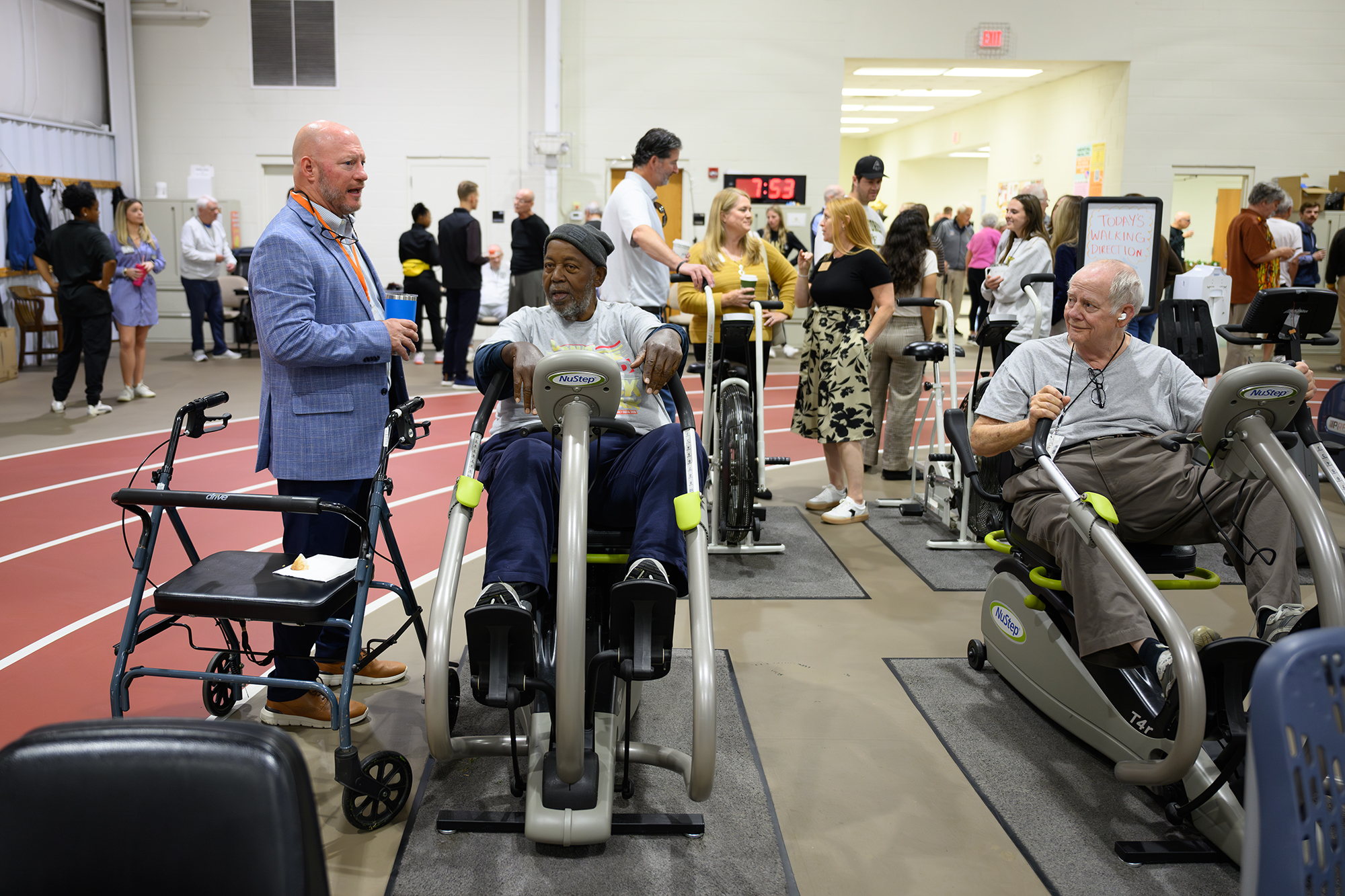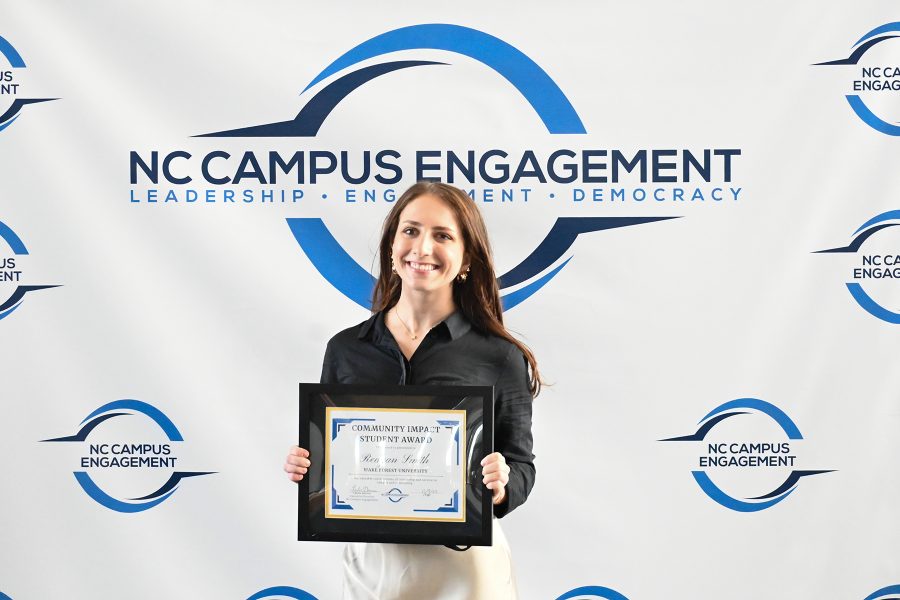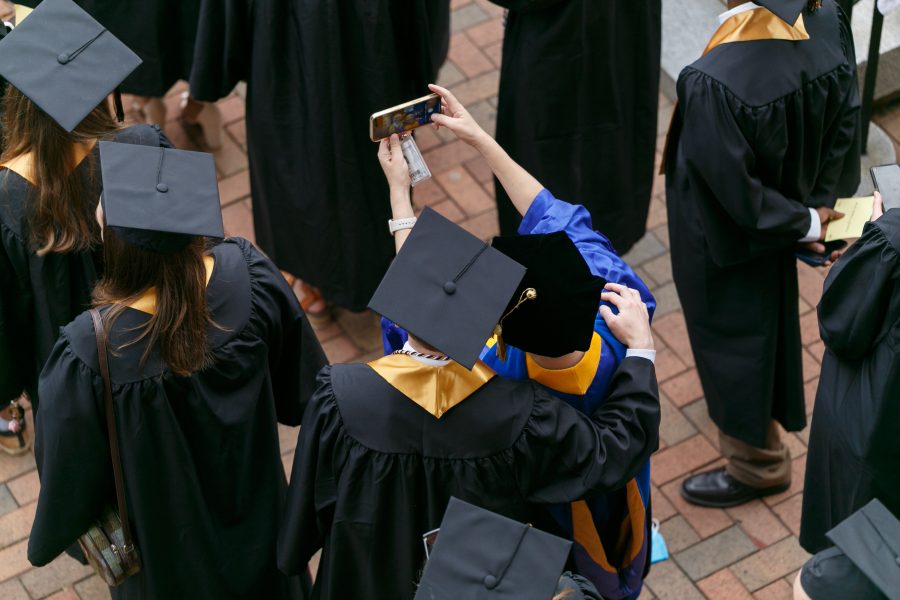Marking 50 years of movement and motivation
Health & Exercise Science Department’s HELPS program inspires healthy choices, fosters supportive community

For 50 years and counting, a program founded at Wake Forest University has helped thousands of people live longer, healthier lives.
Among them is Tom Mullen, the dean of the college from 1968 to 1995, who along with his wife, Ruth, works out three times a week with the Healthy Exercise & Lifestyle Programs (HELPS), run by the Department of Health & Exercise Science (HES).
“Ruth and I largely credit the HELPS program for why we are still living, at 96 years old,” Mullen said.
The Mullens joined HELPS staff, alumni and current participants to celebrate the program’s 50th anniversary with a series of events Oct. 16 and 17. During an open house at the Clinical Research Center off Deacon Boulevard, a fitness center with exercise equipment including weight machines, a running track and space for dance aerobic classes, they commemorated what they consider “50 years of healing hearts.”
The program started in 1975 as a cardiac rehabilitation initiative, founded by HES and focused on getting cardiac patients active. In 2003, it transitioned to HELPS, which takes a more general approach to overall healthcare. Since 1975, more than 8,000 people have sought out the three-times-weekly exercise programs and educational sessions to help improve their health.
It has also served as a training ground for HES graduate students, who have made their mark in the health professions as doctors, physician assistants, clinical exercise physiologists–and even professors at Wake Forest and other universities. About 160 of them, from 1975 to recent years, returned to campus for the HELPS celebration.
Achieving Health Goals
Jeff Katula, the current executive director, describes HELPS as a chronic disease prevention and management program. “As one of the members told me when I first started, ‘We’re a bunch of old people trying to get older,’” he said. “We provide programming to help maintain their health, achieve their health goals, and whatever they need.”
That includes exercise, behavior changes and more. “This is not your ordinary gym,” he said. “This is a very unique community here, where people feel safe, both physically as well as psychologically … so I try to promote an environment that’s conducive to folks feeling welcome, feeling warm, feeling safe, and feeling it’s a place they want to come back to.”
As they made their way among groups of HELPS alumni Friday, former program directors Paul Ribisl and Peter Brubaker talked about how the program expanded from the original version.
Brubaker, who oversaw the program during its transition to HELPS in 2003, noted that “cardiac rehabilitation was really restricted to an individual who had true cardiac disease, who had had bypass surgery, a heart attack, or a stint, and that’s very limiting to who we could serve. So this model was designed to serve a more broad population of individuals who could benefit from healthy lifestyles.”
HELPS is open to both people affiliated with the University and members of the community at large, with exercise programs under medical supervision three times a week. Most participants are in their 60s to 90s, though some are as young as their 20s and 30s. Many pay for the program through insurance, and say it has been a tremendous benefit to them.
‘It’s been a wonderful program’
Melvin Holland, who is now 83, has been participating in HELPS for 22 years, joining in 2003 after a heart attack, and has seen the program grow dramatically. He attends early morning sessions from 6-9 a.m. three days a week.
“It just forces you to get up,” he said. “When you get here, the people are nice.”
His wife, Nancy Holland, 82, came along with Melvin after he made his initial visit and suggested she also join. They have been coming to HELPS together ever since.
“It’s been a wonderful program,” she said. “You don’t even think about whether you’ll get up. … If one of you feels lazy that day, the other one says, ‘Nope, we’re going.’”
Another participant, 86-year-old Ernie Wade, found HELPS after a car accident in 2015. He had played a lot of football in his youth but ended up having to use a walker. The program, he said, “has kept me moving, that’s the most important thing, and understanding the necessity that even as you age you can still get stronger and be strong. I was an athlete, so I sort of took a lot of that for granted, but when it was sort of taken away I kept trying to get it back.”
Graduate students at Wake Forest work with the participants, building bonds and often staying involved in the program even after they graduate.
Devyn Battaglia, a recent grad who spent two years as a student with the program, still works at HELPS as a senior staff member. “It’s a great opportunity for us to stay connected with the program and the participants,” she said. “It’s like a home away from home for us. … These are like our hundred grandparents.”
HELPS sessions occur from 6-9 a.m. Monday, Wednesday and Friday, and 5-7 p.m. Monday, Tuesday and Thursday. For information about joining, call (336) 758-5853 or e-mail Program Director Kristy Wood at lievk20@wfu.edu.
— Contributed by Tim Clodfelter



